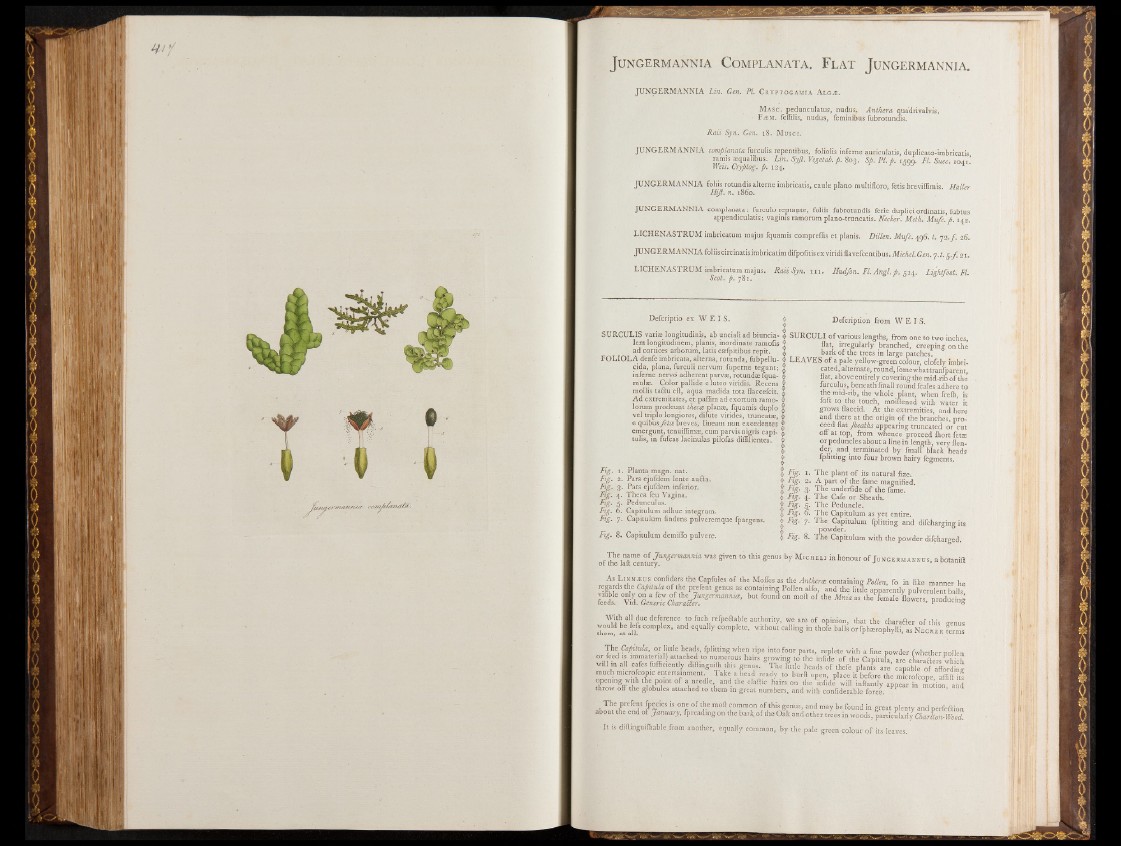
JUNGERMANNIA COMPLANATA. FLAT JUNGERMANNIA.
JUNGERMANNIA Lin. Gen. PI. C r y p t o g a m ia A lgæ .
Masc. pedunculatus, nudus. Anther a quadrivalvis.
• F æm. feflilis, nudus, feminibus fubrotundis.
Raii Syn. Gen. 18. Musci.
JUNGERMANNIA cömfilmata furculis repentibus, foliolis inferne auriculatis, duplicato-irabricatis
ramis æqualibus. Lin. Syfi. Vegctab.fi. 803. Sfi. Pl.fi. 1599. Fl. Suce. 1041.’
Weis. Cryptog. p. 124.
JUNGERMANNIA foliis rotundis alterne imbriçatis, caule piano multifloro, fetis breviflimis. Haller
Hiß. n. i860.
JUNGERMANNIA complanata: furculo reptapte, foliis fubrotundis ferie duplici ordinatis, fubtus
appendiculatis ; vagims ramorum plano-truncatis. Necker. Meth. Muß. fi. 142.
LICHENASTRUM imbricatum majus fquamis compreflis et planis. Dillen. Muß. 496. t. 72./. 26.
JUNGERMANNIA foliis circinatisimbricatimdifpofitisexviridiflavefcentibus. Michd.Gm. j.t .g .f. 21.
LICHENASTRUM imbricatum majus. Raii Syn. t u . Hudfon. Fl. Angl. fi. 514. Lightfoot. Fl.
Scot. p. 781.
Defcriptio ex W E I S.
SURCULIS varioe longitudinis, ab uncialiad biuncia-
lera longitudinem, planis, inordinate ramofis
ad cortices arborum, latis casfpitibus repit.
FOLIOLA denfe imbricata, alterna, rotunda, fubpellu-
cida, plana, furculi nervum fuperne tegunt;
inferne nervd adherent parvze, rotundas fqua-
mulas. Color pallide eluteo viridis. Recens
mollis ta&u eft, aqua madida tota flaccefcit.
Ad extremitates, et paflim ad exortum ramo-
lorum prodeurit thecce planae, fquamis duplo
vel triplo longiores, dilute virides, truncatae,
e quibusy^ta breves, lineam non excedentes
emergunt, tenuiflimas, cum parvis nigris capi-
tulis, in fufeas lacinulas pilofas diflilientes.
1. Planta magn. nat.
2. Pars ejufdem lente aufta.
;. 3. Pars ejufdem inferior.
■. 4. Theca feu Vagina.
•. 5. Pedunculus. g
. o. Capitulum adhuc integrum.
•. 7. Capitulum lindens pulveremque fpargens.
Fig
m
Fig
Fig
Fig
Fig
Fig
| Defcription from WE I S .
$ SURCULI of various lengths, from one to two inches,
| flat, irregularly branched, creeping on the
$ bark o f the trees in large patches.
| LEAVES o f a pale yellow-green colour, clofely imbri-
| cated, alternate, round, fomewhat tranfparent,
f flat> above entirely covering the mid-rib o f the
| furculus, beneath fmall round feales adhere to
I the mid-rib, the whole plant, when frelh, is
I foft to the touch, moiftened with water it
| grows flaccid. At the extremities, and here
| and there at the origin o f the branches, pro-
| ceed flat Jheaths appearing truncated or cut
h off at top, from whence proceed fhort fetae
| or peduncles about a line in length, very flen-
| der, and terminated by fmall black heads
f fplitting into four brown hairy fegments.
$ Fig. 1. The plant o f its natural fize.
§ Pig' 2. A part of the fame magnified.
| -%• 3- The underfide o f the fame.
| Pig- 4* The Cafe or Sheath.
| Pig. 5. The Peduncle.
| Pig- 6. The Capitulum as yet entire.
Y P^S- 7* The Capitulum fplitting and difeharging its
|| powder.
§ Pig' 8. The Capitulum with the powder difeharged.
Fig. 8. Capitulum demiflo pulvere.
o f rtieekft” entu 3 unsnmmnia was Siven l° this Senus by Micheli in honour of Jungermannus, a botanift
As L inn-eu ? confiders the Capfules of the Moffes as the Antherce containing Pollen, fo in like manner he
regards the Cafiltuh of the prefent genus as containing Pollen alfo, and the little apparently pulverulent balls
feeds’.6 Viyd? l e l ^ c l ^ t SCr~ - ^ ^ ^ ° f ^ aS ^ g | g producing
With all due deference to fuch «fpeBable authority/ we are of opinion, that the charaHer of this genus
them at all C° mp a" d equally comPlete’ WIthout calling « thofe balls or fphsrophylli, as Necker terms
The Cafiitula, or little heads, fplitting when ripe into four parts, replete with a fine powder (whether Dollen
or feed is .«material) attached to numerous hairs growing to the infiSe o f the Capitula, are ckaraHers wh ch
will in all cafes fuffic.ently diftmgu.fh this genus. The little heads of thefe plants are capable of afford ng
much microfcopic entertainment Take a head ready to burft open, place it before the microfcope affift it!
opening with the point of a needle and the elaftic hairs on the infide will inflantly appear in motion
throw off the globules attached to them in great numbers, and wilh confiderable force. ,
^ T h e pfelent foecies is one o f the mod common of this genus, and may be found in great plenty and perfeftion
about the end o f January, fpreadmg on the bark,of the Oak and other trees in woods, particularly Charlon-Wood.
It is diflinguidiablc.from another, equally common, by-the pale green colour of its leaves.